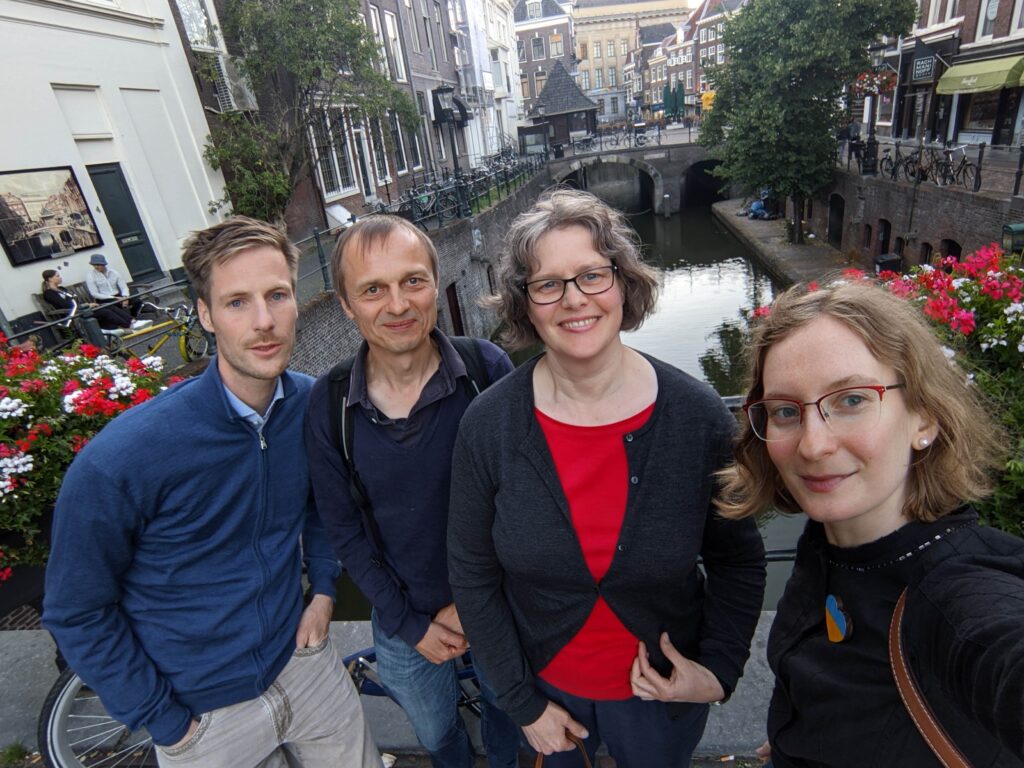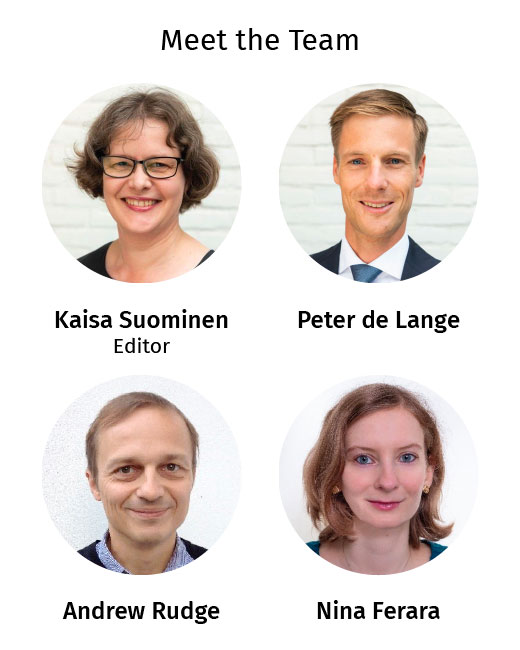The European Patent Convention (EPC) is used daily by many patent practitioners and is essential reading for the thousands of candidates taking the European Qualifying Examination (EQE) each year. Since 1994, Visser’s Annotated European Patent Convention has been providing valuable insights into the EPC to help attorneys practise successfully before the European Patent Office (EPO). For almost 30 years, an annual update has been provided to keep this preeminent work up-to-date, and this year is no exception. This is a good time to have a talk with the editorial team behind the 2023 edition to understand what changes have been made and what it’s like working on the update.
Working together as a team
Kaisa Suominen (Laine IP), Nina Ferara (IBM), Peter de Lange (V.O. Patents & Trademarks), and Andrew Rudge (Pfizer) have continued where Derk Visser left off, making sure that Visser’s Annotated European Patent Convention stays up to date.
Kaisa, who took on the role of editor, and Peter worked together with Derk on his last editions. Kaisa says, ‘I very much admire Derk for having done this on his own for so many years!’ Andrew and Nina have been added to help manage the workload and have been a valuable addition to the team. The fact that the team members have different backgrounds from a work experience and country perspective, has made the team very strong. Andrew: ‘The international team who work together to update Visser aim for the highest standards in achieving an accurate and up-to-date text which is useful for EQE candidates and patent practitioners alike. We work collaboratively together in aiming for this goal. It is a pleasure to work with such highly motivated and knowledgeable people.’ Kaisa echoes the sentiment: ‘I also very much appreciate working in the team, as I have three knowledgeable colleagues with whom I can discuss tricky aspects.’
The difficulty is in making readers feel like the book was written by one person. This challenge does not deter the team. Peter says that updating the book is ‘A privilege and a responsibility because so many EQE candidates rely on the book during the exams and so many practitioners use it as their desk reference.’
Updating the text
Each year, all the relevant new materials are studied by the team and incorporated in the new edition. Kaisa: ‘Typically, when reading a decision or notice originating from the EPO (President, AC, BoA, EBoA), everything initially seems clear. But when you look closely at what has changed and/or try to explain it in writing, things often turn out to be more complicated than first envisaged. If I did not work on this book, I would not read everything with such a high level of precision.’ This level of attention and the corresponding explanations provided are what makes Visser’s Annotated European Patent Convention such a useful resource.
The members of the international team dedicate a lot of their free time to the update but are very happy to do so, even though it sometimes feels both ‘Thrilling and terrifying!’ according to Nina.
Rule 56a harmonizes EPC and PCT
There have been several changes to the EPC regulations this year, and the addition of R.56a is an important example. ‘This rule is brand new’, says Andrew, ‘It allows for the correction of any erroneously filed part of a European patent application, without changing the filing date if the corrected part is contained within the disclosure of an application whose priority was claimed on the filing date. It is therefore complimentary to R.56 which allows for the addition of a missing part (but only if that part is a drawing or a part of the description).’
The team agrees that the most notable thing about the new rule is the harmonisation achieved between the EPC and the PCT, making it easier for both practitioners and EQE candidates alike. Kaisa: ‘It gives applicants an opportunity to correct a mistake that happened during filing, in certain situations. I’m not sure how much it will be used (outside the EQE…), but it’s a kind of safety net.’ Nina is more enthusiastic: ‘As to its use in practice – I suspect that it will be more popular than one may expect’ she continues ‘It also relieves a bit of the burden for candidates studying for the EQE – one fewer PCT difference to remember.’
The EQE candidates will certainly have to pay close attention to the new rule, according to Peter: ‘I expect that the new provision will pop up in one or two tricky EQE questions in the next few years. And in the longer term, will be the basis for some interesting case law.’
Rule 49 will allow for quicker changes
Amended R.49 now gives the President of the EPO (rather than the Administrative Council) the power to determine how the documents making up a European patent application should be presented and to change these requirements as necessary. This will allow the office to make changes more quickly in line with the increasing use of digitisation. Nina: ‘I believe that the intention is to be more agile as an organisation and to be able to streamline minor updates. I see it as a must for our profession, which is tied very closely to innovation and progress.’ Peter already has one request, ‘I hope the EPO will make good use of the provision in the next few years, and formally allow the filing of documents in colour.’
In the short term, it is business as usual. Andrew: ‘No changes have yet been made by the President, but they can be expected in the future.’ The rest of the team fully agree. Kaisa adds: ‘In case the EPO decides to make a number of changes, users will need to follow the OJ closely to keep up-to-date.’
Arrangements for Deposit Accounts (ADA)
A new consolidated ADA is a welcome resource for many practitioners but has some puzzling aspects. ‘It is highly confusing that the fail-safe provision of point 7.5 ADA differs from the one in Rfees 7. I see no logical reason for this divergence’, says Peter.
Andrew explains in a bit more detail, ‘The EPO never seems to be happy with the way in which deposit accounts are managed, and the way they are automatically debited, and is constantly making changes every couple of years! In the latest iteration, for example, if a fee is not deemed to have been paid in time because a deposit account lacked the necessary funds, the late payment is excused if arrangements had already been made to top up the account in the days preceding the expiry of the deadline for paying the fee. Different criteria apply depending on the way the money was transferred to the EPO. It is noted that the EPO has still not extended the use of automatic debiting to supplementary international search.’
Unitary Patent, the new kid on the block
The introduction of the Unitary Patent (UP) and the Unified Patent Court (UPC) is surely the hot topic of this year. As of 1 June 2023, it will be possible to request unitary effect for a European patent within one month of the grant taking effect. This will provide many proprietors with more for less. Peter: ‘Newly granted European patents can be validated in 17 states at once at lower cost. This will make European patents more attractive to applicants.’ Andrew strikes a note of caution, however, since a unitary patent will have to be litigated in the new Unified Patent Court, ‘Many proprietors are wary of using the court until its practice and case law has been established and will not initially be requesting unitary effect for their most important patents as a result.’
And further…
There are numerous other updates in the new edition. Peter managed to squeeze in a few brief remarks about the new Enlarged Board of Appeal decision in case G 2/21 (“plausibility”). Kaisa: ‘Thanks to Wolters Kluwer’s flexibility and Peter’s quick work, we managed to include first comments on G2/21, although it was published after the cut-off date.’
Both Nina and Andrew mention the addition of a new state to the EPC. Andrew: ‘It is a pleasure to welcome Montenegro as the 39th member of the European Patent Organisation. For European patent applications filed on or after 01 October 2022, Montenegro will be a contracting state rather than an extension state.’
With this year’s update finalised, the authors are already looking forward to the next edition. Peter, ‘My prediction for the hot topics of next year? Probably we will see another referral to the Enlarged Board about the status of video conference oral proceedings now that Covid-related travel restrictions seem to be over.’
Visser’s Annotated European Patent Convention, 2023 edition

The update is useful for exam candidates and patent attorneys. ‘A colleague even said it was useful in the EPAC-exam, which she successfully took’ says Kaisa.
Nina has the following advice for trainees, ‘EQE candidates: hang in there! The EPC & its various add-ons can look overwhelming (like ADA still does to me!), but you will slowly start feeling more at ease with it’. Her message to practitioners? ‘Let’s strive to make our profession more inclusive and let’s be kind to each other!’ Andrew follows with, ‘Work hard and stay calm.’
The new edition of Visser’s Annotated European Patent Convention is now available.
________________________
To make sure you do not miss out on regular updates from the Kluwer Patent Blog, please subscribe here.



